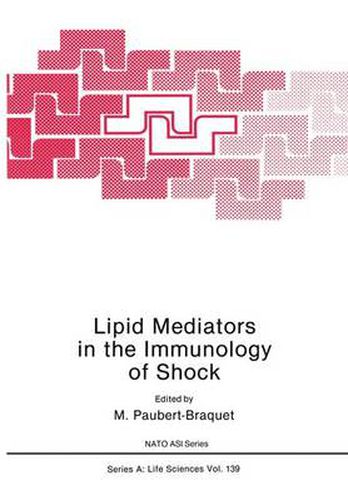Readings Newsletter
Become a Readings Member to make your shopping experience even easier.
Sign in or sign up for free!
You’re not far away from qualifying for FREE standard shipping within Australia
You’ve qualified for FREE standard shipping within Australia
The cart is loading…






This title is printed to order. This book may have been self-published. If so, we cannot guarantee the quality of the content. In the main most books will have gone through the editing process however some may not. We therefore suggest that you be aware of this before ordering this book. If in doubt check either the author or publisher’s details as we are unable to accept any returns unless they are faulty. Please contact us if you have any questions.
This book contains the proceedings of the ARW NATO conference on Lipid Mediators in Immunology of Burn and Sepsis held in He1singor, Denmark, July 20-25, 1986. This meeting brought together some of the most distinguished re- searchers in the fields of thermal injury, the immune system and lipid mediator biochemistry. It is well known that there is a substantial impairment of the immune response during sepsis, burn, trauma and other kinds of shock. These conditions are characterized by a massive inflammatory process which occurs during the early phase following injury. Among the various mediators released at this time are 1euko- trienes, thromboxane, histamine and platelet-activating factor. This latter autocoid possesses potent proinf1ammatory properties and toge- ther with the other mediators may account for some of the post-injury pathophysi 01 ogi ca 1 phenomena such as extravasati on, hypotensi on, chemotaxis…It is of great interest to note that recently 1euko- tri enes and plate 1 et-acti vati ng factor have been shown to be potent mediators of the immune response. Thus, the purpose of this meeting was to bring together clinicians, immunologists and biochemists in order to examine and hopefully clarify the putative role of various lipid mediators prominent in the early stages after injury. This book is divided into the following six sections. Section 1 provides a general overview of the physiological con- sequences of burn, sepsis and shock.
$9.00 standard shipping within Australia
FREE standard shipping within Australia for orders over $100.00
Express & International shipping calculated at checkout
This title is printed to order. This book may have been self-published. If so, we cannot guarantee the quality of the content. In the main most books will have gone through the editing process however some may not. We therefore suggest that you be aware of this before ordering this book. If in doubt check either the author or publisher’s details as we are unable to accept any returns unless they are faulty. Please contact us if you have any questions.
This book contains the proceedings of the ARW NATO conference on Lipid Mediators in Immunology of Burn and Sepsis held in He1singor, Denmark, July 20-25, 1986. This meeting brought together some of the most distinguished re- searchers in the fields of thermal injury, the immune system and lipid mediator biochemistry. It is well known that there is a substantial impairment of the immune response during sepsis, burn, trauma and other kinds of shock. These conditions are characterized by a massive inflammatory process which occurs during the early phase following injury. Among the various mediators released at this time are 1euko- trienes, thromboxane, histamine and platelet-activating factor. This latter autocoid possesses potent proinf1ammatory properties and toge- ther with the other mediators may account for some of the post-injury pathophysi 01 ogi ca 1 phenomena such as extravasati on, hypotensi on, chemotaxis…It is of great interest to note that recently 1euko- tri enes and plate 1 et-acti vati ng factor have been shown to be potent mediators of the immune response. Thus, the purpose of this meeting was to bring together clinicians, immunologists and biochemists in order to examine and hopefully clarify the putative role of various lipid mediators prominent in the early stages after injury. This book is divided into the following six sections. Section 1 provides a general overview of the physiological con- sequences of burn, sepsis and shock.